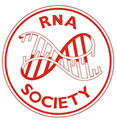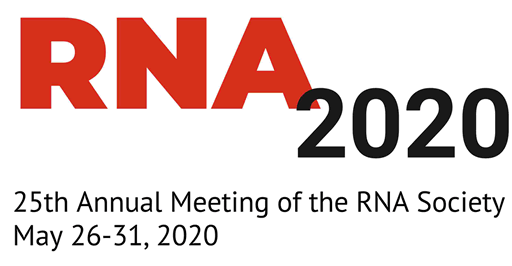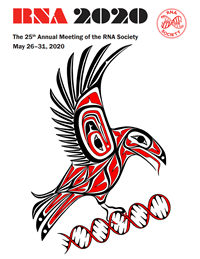Awardees
2020 RNA Society Lifetime Achievement Award
We are pleased to announce Matthias Hentze as the recipient of the 2020 RNA Society Lifetime Achievement Award.
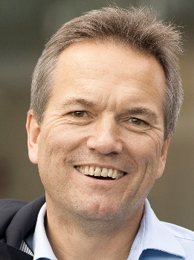 Matthias Hentze, Professor and Director at the European Molecular Biology Laboratory in Heidelberg, Germany, is recognized for his longstanding contributions in the fields of RNA biology and gene regulation. Matthias’ early work focused on translation regulation, having identified the first cis-acting mRNA regulatory element and RNA binding protein partner during the regulation of iron homeostasis in mammalian cells. More recently, the Hentze lab has developed mRNA interactome capture to identify hundreds of previously uncharacterized RNA-binding proteins – a critical advance in elaborating RNP networks in the cell. Discoveries by the Hentze group have contributed not only to our fundamental understanding of gene control at the level of RNA but have also provided critical insight in the areas of developmental biology, brain function, cancer development and other diseases. In addition to his significant scientific contributions, Matthias is recognized for his leadership, training and mentoring of hundreds of young scientists within his lab, at EMBL, and throughout Europe. Matthias will present his award talk at RNA 2021 in Singapore.
Matthias Hentze, Professor and Director at the European Molecular Biology Laboratory in Heidelberg, Germany, is recognized for his longstanding contributions in the fields of RNA biology and gene regulation. Matthias’ early work focused on translation regulation, having identified the first cis-acting mRNA regulatory element and RNA binding protein partner during the regulation of iron homeostasis in mammalian cells. More recently, the Hentze lab has developed mRNA interactome capture to identify hundreds of previously uncharacterized RNA-binding proteins – a critical advance in elaborating RNP networks in the cell. Discoveries by the Hentze group have contributed not only to our fundamental understanding of gene control at the level of RNA but have also provided critical insight in the areas of developmental biology, brain function, cancer development and other diseases. In addition to his significant scientific contributions, Matthias is recognized for his leadership, training and mentoring of hundreds of young scientists within his lab, at EMBL, and throughout Europe. Matthias will present his award talk at RNA 2021 in Singapore.
2020 RNA Society Lifetime Service Award
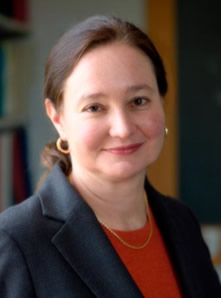 We are pleased to announce Sarah Woodson has been awarded the 2020 RNA Society Lifetime Service Award.
We are pleased to announce Sarah Woodson has been awarded the 2020 RNA Society Lifetime Service Award.
Sarah Woodson, the T.C. Jenkins Professor of Biophysics at Johns Hopkins University, is recognized for her years of contribution and service to the RNA Society. In addition to her successful research program, Sarah has generously dedicated her time and leadership under a variety of society roles including Director (2006 – 2007), Secretary (2000 – 2002) and, most recently, as society President (2015-2016) – serving the first two-year presidential term upon the revision of society bylaws and expansion of the role in 2015. During her time as a Society member, Sarah has also served on the Nominating Committee, and in almost every role during one or more of our annual meetings, including mentor, poster judge, Session Chair, and co-organizer (for the 2000 meeting in Madison, Wisconsin, and 2013 meeting in Davos, Switzerland). Sarah continues her long history of service in her role as lead organizer of RNA2020 this year in Vancouver, Canada.
2020 Elisa Izaurralde Award Winner
The RNA Society is very pleased to announce that Lori Passmore is the recipient of the inaugural 2020 Elisa Izaurralde Award.
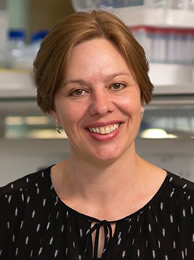 Lori Passmore, from the MRC Laboratory of Molecular Biology in Cambridge, UK, is the first recipient of the Elisa Izaurralde Award. Lori has made outstanding contributions to our understanding of the mechanisms of RNA polyadenylation and deadenylation and their coupling to transcription and translation. Her courage and commitment to long-term challenging projects, along with her contributions to the development of cryo-EM methods, allowed her to functionally reconstitute and determine the structure of large multi-protein complexes involved in nucleic acids metabolism, including the 1MDa cleavage and polyadenylation (CPF) complex, the 0.5 MDa Ccr4-Not deadenylation complex and the Fanconi anemia ubiquitin ligase complex. A concept emerging from her work is that the regulatory properties of such complexes critically depend on the entangled activities and mutual influences of their components. Lori is also a dedicated mentor and a passionate science educator and activist. She was nominated by Kevin Weeks and Witek Filipowicz. Lori will present abstract 341 in Plenary Session 1.
Lori Passmore, from the MRC Laboratory of Molecular Biology in Cambridge, UK, is the first recipient of the Elisa Izaurralde Award. Lori has made outstanding contributions to our understanding of the mechanisms of RNA polyadenylation and deadenylation and their coupling to transcription and translation. Her courage and commitment to long-term challenging projects, along with her contributions to the development of cryo-EM methods, allowed her to functionally reconstitute and determine the structure of large multi-protein complexes involved in nucleic acids metabolism, including the 1MDa cleavage and polyadenylation (CPF) complex, the 0.5 MDa Ccr4-Not deadenylation complex and the Fanconi anemia ubiquitin ligase complex. A concept emerging from her work is that the regulatory properties of such complexes critically depend on the entangled activities and mutual influences of their components. Lori is also a dedicated mentor and a passionate science educator and activist. She was nominated by Kevin Weeks and Witek Filipowicz. Lori will present abstract 341 in Plenary Session 1.
2020 Mid-Career Award Winner
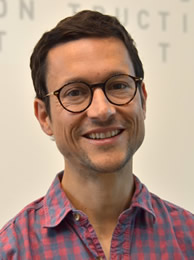 Jernej Ule, from UCL and The Francis Crick Institute in London, UK, is the recipient of this year’s Mid-Career Award. Jernej has been instrumental – initially during his PhD in the laboratory of Bob Darnell and then as Group Leader at the LMB – for the development of highly popular CLIP methods to study RNA-Protein and RNA-RNA interactions. These, in turn, have been essential to establish transcriptome-wide positional effects of regulatory factors in alternative splicing decisions (RNA Maps), including proteins involved in neurodegenerative disease. His group also established the widespread occurrence of recursive splicing in the mammalian brain and its regulation by exon junction complexes, as well as the key role that transposable elements play in shaping the evolution of post-transcriptional mechanisms. Jernej is a dedicated mentor and a generous contributor to the RNA community, including the organization of courses and workshops. He was nominated by Chris Smith. Jernej will present abstract 85 in Plenary Session 3.
Jernej Ule, from UCL and The Francis Crick Institute in London, UK, is the recipient of this year’s Mid-Career Award. Jernej has been instrumental – initially during his PhD in the laboratory of Bob Darnell and then as Group Leader at the LMB – for the development of highly popular CLIP methods to study RNA-Protein and RNA-RNA interactions. These, in turn, have been essential to establish transcriptome-wide positional effects of regulatory factors in alternative splicing decisions (RNA Maps), including proteins involved in neurodegenerative disease. His group also established the widespread occurrence of recursive splicing in the mammalian brain and its regulation by exon junction complexes, as well as the key role that transposable elements play in shaping the evolution of post-transcriptional mechanisms. Jernej is a dedicated mentor and a generous contributor to the RNA community, including the organization of courses and workshops. He was nominated by Chris Smith. Jernej will present abstract 85 in Plenary Session 3.
2020 Early-Career Award Winner
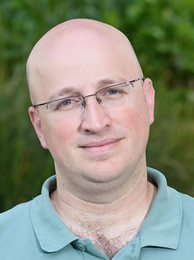 Igor Ulitsky, from the Weizmann Institute of Science in Rehovot, Israel, is the recipient of this year’s Early-Career Award. Originally trained as a computational biologist, Igor became interested in experimental biology and long non-coding RNAs during his postdoc in David Bartel’s lab. Since the establishment of his independent group six years ago, Igor has become a leader in studies to decipher the evolution, biological roles and mechanisms of lncRNAs. Igor’s contributions include the demonstration of the role of lncRNAs in neuron regeneration, the role of sequences enriched in Alu repeats in the nuclear localization of lncRNAs and how these molecules modulate the activity of RNA binding proteins such as Pumilio repressors. The group also develops high-throughput methods to assess function through RNA localization and a rich toolbox for the identification of lncRNA homologs. Igor has also generously contributed to spread the importance of the biology of non-coding RNAs by organizing workshops, meetings and courses. Igor will present abstract 578 in Plenary Session 5.
Igor Ulitsky, from the Weizmann Institute of Science in Rehovot, Israel, is the recipient of this year’s Early-Career Award. Originally trained as a computational biologist, Igor became interested in experimental biology and long non-coding RNAs during his postdoc in David Bartel’s lab. Since the establishment of his independent group six years ago, Igor has become a leader in studies to decipher the evolution, biological roles and mechanisms of lncRNAs. Igor’s contributions include the demonstration of the role of lncRNAs in neuron regeneration, the role of sequences enriched in Alu repeats in the nuclear localization of lncRNAs and how these molecules modulate the activity of RNA binding proteins such as Pumilio repressors. The group also develops high-throughput methods to assess function through RNA localization and a rich toolbox for the identification of lncRNA homologs. Igor has also generously contributed to spread the importance of the biology of non-coding RNAs by organizing workshops, meetings and courses. Igor will present abstract 578 in Plenary Session 5.
RNA Society/Scaringe Post-Doctoral Award
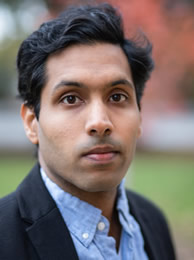 Furqan Fazal is a postdoctoral researcher in the laboratory of Howard Y. Chang at Stanford University School of Medicine in Stanford, California. While in the Chang lab, Furqan worked on a method to map RNA secondary structures in different compartments of the cell. The method, APEX-Seq, has excellent spatial and temporal resolution that can be applied to map RNA localization at sites not amenable to biochemical purification. Using this technique, Furqan has discovered that that mRNA isoforms of the same gene often have distinct localization patterns and has identified specific RNA elements that direct localization to distinct nuclear territories and cytoplasmic organelles. Furqan has been awarded the Stanford Genomics Training T32 Award, the prestigious Beckman Fellowship, as well as an NHGRI K99/R00 award. He has been a member of the RNA Society since 2018. Furqan will present abstract 132 in Poster Session 2.
Furqan Fazal is a postdoctoral researcher in the laboratory of Howard Y. Chang at Stanford University School of Medicine in Stanford, California. While in the Chang lab, Furqan worked on a method to map RNA secondary structures in different compartments of the cell. The method, APEX-Seq, has excellent spatial and temporal resolution that can be applied to map RNA localization at sites not amenable to biochemical purification. Using this technique, Furqan has discovered that that mRNA isoforms of the same gene often have distinct localization patterns and has identified specific RNA elements that direct localization to distinct nuclear territories and cytoplasmic organelles. Furqan has been awarded the Stanford Genomics Training T32 Award, the prestigious Beckman Fellowship, as well as an NHGRI K99/R00 award. He has been a member of the RNA Society since 2018. Furqan will present abstract 132 in Poster Session 2.
RNA Society/Scaringe Post-Doctoral Award
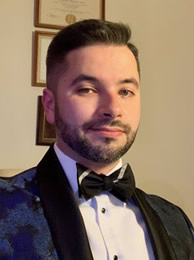 Sebastian Fica is a postdoctoral researcher in the laboratory of Professor Kiyoshi Nagai at the MRC Laboratory of Molecular Biology in Cambridge, UK. Sebastian has utilized CryoEM to elucidate the three-dimensional structure of a number of splicing complexes at near atomic resolution. He has solved the structures of the yeast C* splicing complex; a complex that has completed the first step splicing reaction and is poised to catalyze the exon ligation reaction. He also worked with coworkers Galej and Wilkinson to elucidate the yeast C splicing complex structure. He then established a HeLa system to study mammalian splicing complexes, devised a strategy to purify mammalian post-catalytic P spliceosomes, and then helped to solve the structure of those complexes. He has received the Departmental Award for Outstanding Performance in the Field of Cell and Molecular Biology from the University of Chicago as well as a Best Dissertation Award also from the University of Chicago. He has been a member of the RNA Society since 2009.
Sebastian Fica is a postdoctoral researcher in the laboratory of Professor Kiyoshi Nagai at the MRC Laboratory of Molecular Biology in Cambridge, UK. Sebastian has utilized CryoEM to elucidate the three-dimensional structure of a number of splicing complexes at near atomic resolution. He has solved the structures of the yeast C* splicing complex; a complex that has completed the first step splicing reaction and is poised to catalyze the exon ligation reaction. He also worked with coworkers Galej and Wilkinson to elucidate the yeast C splicing complex structure. He then established a HeLa system to study mammalian splicing complexes, devised a strategy to purify mammalian post-catalytic P spliceosomes, and then helped to solve the structure of those complexes. He has received the Departmental Award for Outstanding Performance in the Field of Cell and Molecular Biology from the University of Chicago as well as a Best Dissertation Award also from the University of Chicago. He has been a member of the RNA Society since 2009.
RNA Society/Scaringe Graduate Student Award
 Robert Battaglia is a graduate student in the laboratory of Dr. Ailong Ke at Cornell University in Cornell, New York. While working in the Ke lab, Robert first crystalized and elucidated the structure of the guanidine-sensing ykk riboswitch using X-ray crystallography. He then worked with an undergraduate, Itai Levi, to establish a genetic screen to identify the genetic conditions that turn on or off a number of orphan riboswitches. Robert than turned his attention to determining the X-ray crystal structures of the Glycine T-box riboswitch bound to its cognate tRNA. He succeeded in obtaining first the structure of the complex with uncharged tRNA (at 2.9 Å resolution), then the structure of the T-box bound to tRNA containing a 2’3’-cyclic phosphate. The latter mimics a charged tRNA and showed that the T-box riboregulator initially can accommodate the binding of both forms of tRNA, uncharged and charged. He has been a member of the RNA Society since 2017. Robert will present abstract 373 in Poster Session 7.
Robert Battaglia is a graduate student in the laboratory of Dr. Ailong Ke at Cornell University in Cornell, New York. While working in the Ke lab, Robert first crystalized and elucidated the structure of the guanidine-sensing ykk riboswitch using X-ray crystallography. He then worked with an undergraduate, Itai Levi, to establish a genetic screen to identify the genetic conditions that turn on or off a number of orphan riboswitches. Robert than turned his attention to determining the X-ray crystal structures of the Glycine T-box riboswitch bound to its cognate tRNA. He succeeded in obtaining first the structure of the complex with uncharged tRNA (at 2.9 Å resolution), then the structure of the T-box bound to tRNA containing a 2’3’-cyclic phosphate. The latter mimics a charged tRNA and showed that the T-box riboregulator initially can accommodate the binding of both forms of tRNA, uncharged and charged. He has been a member of the RNA Society since 2017. Robert will present abstract 373 in Poster Session 7.
